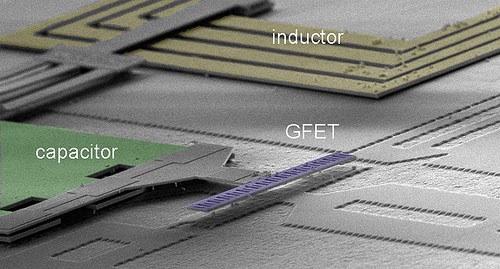
Image via IBM
Graphene is a semiconductor material that heightens the proficiency of wireless devices. Since its potential has been realized by researchers, professionals at IBM have been analyzing its practicality for wireless and radio-frequency use in communications. This discovery has led to new actualized possibilities of carbon-based electronics and its applications with circuits that go beyond silicon chips. There are many beneficial electrical properties of graphene that make it a greatly universal substance to be used in mobile devices for transmitting larger amounts of data at a rapid pace. Graphene circuits are also significantly less expensive than the current circuits used in cell phones.
Graphene was produced in 2004 by scholars at the University of Manchester. The substance is a thin nanomaterial that contains a single layer of carbon atoms packed in a honeycomb structure. It has been proven that this material has optical, thermal, electrical, mechanical capabilities to make amazing contributions to the world of electronics; graphene will be significantly more energy efficient than traditional silicon electronics. This technology will be especially beneficial for transmitting long distance data from devices like smart sensors and RFID tags.

Image via IBM
During previous experimentation, the material appeared to be very delicate, increasing the chance of a broken device from the flow of conventional integrated circuits. In 2011, IBM researchers built an analog graphene integrated circuit with a broadband frequency mixer. During the test run, the graphene transistor’s performance suffered from the abrasive fabrication process. At present, the team at IBM has improved its functionality, honing in its functionality with wireless communications. IBM used a new method that is similar the manufacturing process of silicon CMOS. With this setup, the multistage graphene integrated RF receiver was tested. This circuit was able to transmit sample text messages that the researchers sent. Hence, the fully functional nano-scale graphene circuit was completely suited for use in wireless communications, providing a cost effective, high-speed solution for transmitting tremendous amounts of data.
Recently, scientists have created a method to preserve the transistor quality, producing a highly functional graphene integrated circuit. This updated circuit carries out tasks 10,000 faster than the first graphene circuit prototypes. While operating, graphene circuits consume under 20 mW of power, and show an extremely high conversion gain of any other graphene RF circuits at various GHz frequencies. The trial text messages sent by the researchers were transmitted with a 4.3 GHz signal.
The team at IBM has published their analysis and research in Graphene radio frequency receiver integrated circuit , an article in Nature Communications.
Story via Phys.org, Nature.com
Advertisement
Learn more about Electronic Products Magazine





